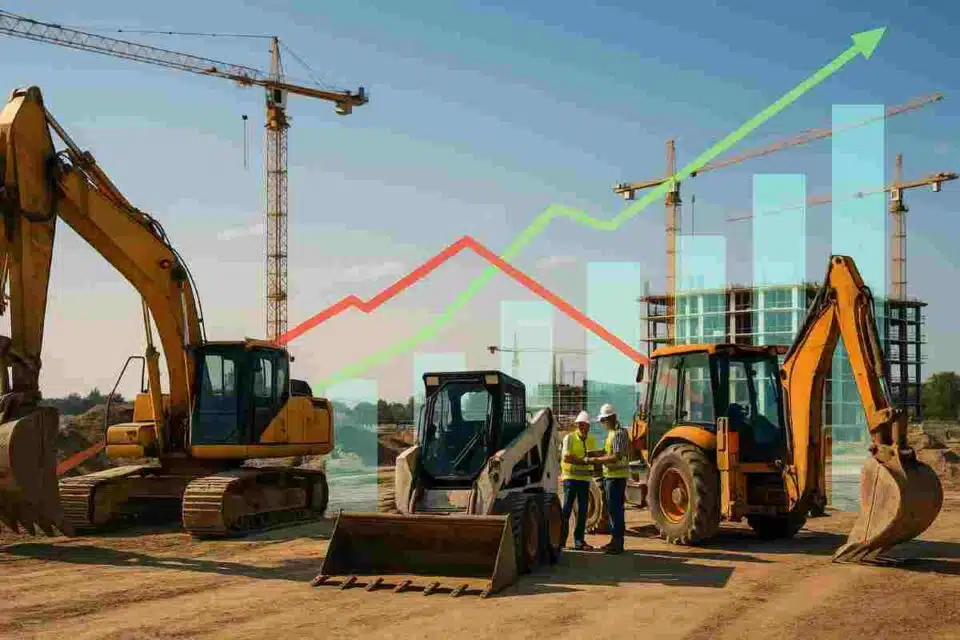Last Updated on July 10, 2025 by Admin
Inflation keeps squeezing project margins, but your fleet budget doesn’t have to bleed. You can flatten your equipment spend by pairing fresh cost data with disciplined asset management strategies, even while iron and steel prices keep creeping up. Unpack the numbers and then dive into the actions that keep more cash on your balance sheet.
Table of Contents
The Cost Landscape for Construction Equipment
Gordian’s latest RSMeans release shows that price hikes are calming but still hurt. Equipment costs are up 4.5% year-on-year, while materials registered a 3.1% rise. Half of all material items swung at +/-5%, and a full 68% of equipment line items moved outside that band. Volatility is tighter but not gone.
Tariff exposure adds pressure. In May 2025, construction input prices rose 0.2% month-over-month, led by iron and steel. Associated Builders and Contractors economists warn that the June 4 tariff hike from 25% to 50% will keep that escalation alive for several quarters. With that backdrop, shaving even a small percent from ownership or operating costs can decide whether a bid wins or a project finishes in the black.
Practice 15+ AI-generated technical and HR interview questions for Civil, BIM, QS, Planning, HSE and Construction roles. Get instant feedback, improved answers, a 7-day improvement plan, and a full PDF report. Designed exclusively for construction professionals.
One free full interview session included. No credit card required.
5 Moves to Tame Construction Equipment Spend
These five tactics deliver reliable savings for small GC fleets and ENR Top 400 giants. Find out which levers fit your operation.
1. Turn Data into Fuel Savings with Telematics and AI
Telematics adoption is soaring — $1.5 billion in 2024 and a projected 12.4% compound annual growth rate through 2034. The return on investment is clear — Penske’s Fleet Insight pulls 300 million data points daily to flag maintenance issues before trucks sideline a job. Furthermore, Siemens reports that its Senseye platform users saw maintenance costs drop by 40% and downtime halve. Even without enterprise-grade AI, installing basic fuel-tracking devices can cut idle time enough to pay for the hardware in one season.
2. Apply the 50/50 Threshold When Deciding to Rebuild or Replace
Worn equipment bleeds money in labor, fuel and delay claims, yet a new unit ties up capital. The 50/50 rule provides a guardrail — keep the machine until expected repairs are at 50% of replacement cost. Use your telematics data to forecast the repair curve, then budget rebuilds or swaps before catastrophic failure inflates costs.
3. Rent or Share for Flexibility
Ownership makes sense for high-utilization core pieces, but most fleets carry underused specialty gear. Rental prices remain competitive — the global rental market hit $147 billion in 2024 and is set to grow 6.2% annually through 2034, driven by contractors chasing cash flow agility. Watch local rental indices, negotiate multi-month blocks for big projects and don’t overlook peer-to-peer cooperatives that keep equipment working inside your trade network between jobs.
4. Finance on Your Terms, Not the Lender’s
Rising rates ruin savings if you lock in poor terms. In July 2025, equipment loan annual percentage rates spanned roughly 2%-20%, depending on credit and collateral. Shop multiple lenders, explore 100% financing to conserve cash and model the total cost against rental scenarios. A five-year fixed loan looks cheap at 5%, but a one-point rate drop next quarter can flip the math, so keep prepayment clauses flexible.
5. Buy Together, Build Faster
Cooperative purchasing isn’t just for municipalities. Job Order Contracting co-ops allow pre-bidding for heavy equipment and services, letting members tap volume discounts. For private firms, forming a regional buying group for high-priced attachments or wear parts can unlock a similar scale.
Fast Fleet Fixes You Can Deploy Now
Making small tweaks today can shave costs and boost uptime faster than any budget overhaul. Drop these into your workflow and see the savings stack up:
- Standardize attachments: Shared couplers across excavators and loaders help trim your parts inventory and make rental swaps painless.
- Coach operators on eco modes: Proper fuel-saving settings cut idle burn and keep maintenance intervals from closing in too quickly.
- Reevaluate insurance deductibles: A low deductible isn’t always cheaper — model different scenarios to find the sweet spot where risk and premiums balance out.
Inflation’s Hidden Advantage
Cost spikes grab headlines, but the contractors who out-execute peers quietly redirect those dollars into backlog growth. Treat your fleet like an investment portfolio — diversify, monitor and rebalance — and inflation turns from a threat into a catalyst for smarter operations.
Related Posts:
- The Impacts of Inflation on the Real Estate Industry
- Effective Ways To Cut Costs In The Logistics Industry
- 6 Essential Skills for Managing Heavy Equipment Fleets in the Construction Industry
- Tips For Driving Down Fleet Fuel Bills


